3 August 2012 (
Cervantes Other Side, Denver CO)
The crowd was pretty thin when Irie Still took the stage, even though they started a bit late. By the end of the set, things filled out nicely, though. DJ Uplifter offered some high volume, bass heavy reggae tracks between sets. The tunes were fine, but the sound didn't fit the vibe.
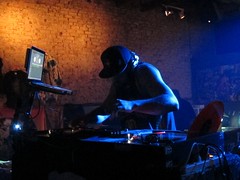
Sister Carol made it all better with her set -- two hours of her reggae medicine was exactly what we needed.
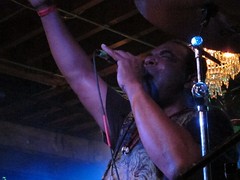
Frontman Ronny Noel was a natural performer. He had that gifted ability to draw the crowd's total attention with confidence but still leave room for the rest of the band to shine. That allowed Irie Still to maintain a balance that was fully dedicated to the music over individual personality. Even though Noel stood out, percussionist Ray Cruz also brought his own charisma to the stage, adding shout outs and whistle bursts to keep the energy strong.
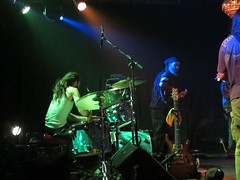
The heartbeat of the band, the rhythm section, laid down a solid reggae drive. That trio of tight punchy drums, a grounding bass lifeline, and tastefully syncopated percussion were locked down into the deepest of pockets. Noel occasionally joined in with his djembe and added his beats.
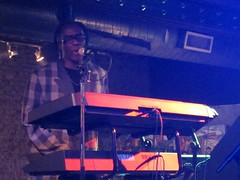
The keys meshed in perfectly, whether weaving in a bubble chank or tossing in melody. The guitarist was good, but he tended to focus more on fills. Being low in the mix didn't help: even when he laid in a chank, it didn't pop like it should. His fills on the soca were stronger, though.
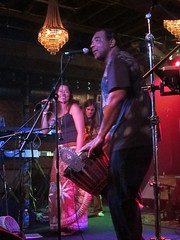
While Noel drove the lead vocals, Celena Otero provided some sweet harmonies and backing lines. She had a clean voice that showed some depth. Irie Still should get her singing more leads and developing a more active stage presence to broaden the band's energy.
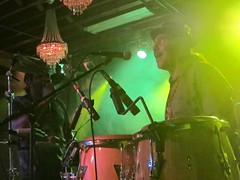
The songs kept the crowd dancing. While the focus was on reggae, Irie Still tossed in some ska, dancehall, and soca grooves to stir the pot. I especially liked their darker, moodier cover of
Get Up, Stand Up. This Denver band was a great opener for Sister Carol.
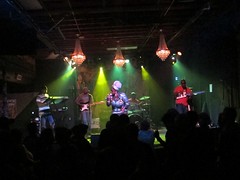
When I first heard
Isis - "The Original Womb-Man" (
review), I was drawn to Sister Carol's charisma and energy. Her woman-worship, conscious lyrics were strong and positive. But most of all, the music was tight and grounded in a roots style. Even though
Isis is from 1999, I hoped she'd bring the same edge to her show at Cervantes. I just needed to remember the unofficial Jamaican motto, "
Don't worry" -- Sister Carol has developed like a fine wine over the years.

Her voice was darker and richer, but she still brought in some of the sassy attitude of her younger days. Perhaps in honor of her earlier recording with the Hi Life Players, her backing band had the same name, although they seemed too young to have played with her back in 1984. Unlike Irie Still, the Hi Life Players were primarily there to provide the perfect setting for Sister Carol's larger than life presence. But that didn't stop them from showing off some phenomenal playing while they anchored the grooves. Soaking in the rhythms, it was easy to take them for granted as Sister Carol sang, but then they'd surprise us by standing out with a flashy fill, a soulful vocal line, or a pumping bass.

The Hi Life Players opened the set by themselves to warm up the crowd. Their four piece (drum, bass, keys, and guitar) had a full sound and their guitar player offered some strong vocals and good stage presence.

After their single song warmup, they brought out Sister Carol's daughter,
Nakeeba Amaniyea, for a short, four song set. Like her mother, Amaniyea had a strong stage presence with a positive, joyful vibe. Her vocal sound was rooted in R&B, but she showed off her chops in several styles. On
My Jamaica, the dramatic lighting set up a mellow, soulful start. As the song picked up strength, Amaniyea laid down a smooth flow of rap lyrics. On her newer single,
Roots Rasta, the music had a faster ska beat and a dancehall energy. The high point of her set, though, was a freestyle rap. She laid down a nice East Coast cadence, but with some of Michael Franti's conscious flow.

After Amaniyea left the stage, Sister Carol took the stage like it was her home. Introduced as an empress, she was draped in a Rastafarian flag and her regal style showed. With her strong posture, her panther poise, and wicked sunglasses, she had the allure of Grace Jones.
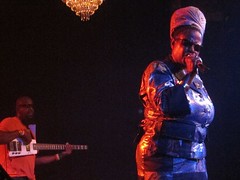
The set kicked off with an uptempo version of
For the Conquering Lion, which showcased Sister Carol's strong voice. It was a joy to see her work the stage, whether it was connecting with the crowd at the edge of the stage or projecting to the back of the room.
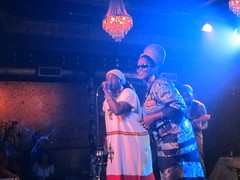
She hit lot of older songs, like my favorite
Rasta Girl, as well a new tracks, including the crowd pleasing
Medical Marijuana. It was particularly nice when she brought her daughter back out so they could perform together. Sister Carol tossed in her backing vocals while Nakeeba took the lead.
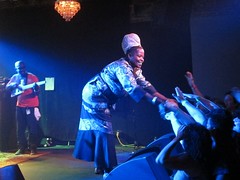
Over the years, she's clearly settled into her Mother Culture role. Even so, things never got too serious as her warm personality came through. She wrapped up the set with her iconic cover of
Wild Thing, which gave the guitarist a chance to show that he could rock out. Then she settled in at the merch table to graciously greet her fans and sign autographs.
More photos on my
Flickr.
 I first heard The Men when they released their Record Store Day single, A Minor (review). That track serves as a good intro to what this band does well. Over the course of eight minutes it builds an extended hypnotic trip that culminates in a harder edged heavy metal grind. That balance of soft and hard is the core of the band's musical approach.
I first heard The Men when they released their Record Store Day single, A Minor (review). That track serves as a good intro to what this band does well. Over the course of eight minutes it builds an extended hypnotic trip that culminates in a harder edged heavy metal grind. That balance of soft and hard is the core of the band's musical approach. As the house band for Easy Star records, the
As the house band for Easy Star records, the  It seems appropriate that
It seems appropriate that  Like most of white America, my introduction to rap came from The Sugarhill Gang's Rapper's Delight. Grandmaster Flash, Run DMC, and Blondie (Rapture) soon followed. The cadences and interlocking rhythmns were like a new kind of modern art. There were rules and influences I could only guess at. The lyrics were interesting, but not particularly deep or challenging.
Like most of white America, my introduction to rap came from The Sugarhill Gang's Rapper's Delight. Grandmaster Flash, Run DMC, and Blondie (Rapture) soon followed. The cadences and interlocking rhythmns were like a new kind of modern art. There were rules and influences I could only guess at. The lyrics were interesting, but not particularly deep or challenging.
 Many bands aspire to the retro haze of garage psychedelia, filling their tracks with a messy wall of guitar fuzz and driving beats. Emphasizing the garage side, they revel in the sloppy catharsis of low-fi sound.
Many bands aspire to the retro haze of garage psychedelia, filling their tracks with a messy wall of guitar fuzz and driving beats. Emphasizing the garage side, they revel in the sloppy catharsis of low-fi sound. After catching
After catching  On their last EP, As American As Ones and Zeros (
On their last EP, As American As Ones and Zeros ( The early '70s were a fertile hot zone. All the disparate musical shards of the hippie '60s -- folk, pop psychedelia, acid rock, and blues -- were starting to slide together into interesting combinations. Bands like Bad Company, the Band, and the James Gang created sounds that were anchored in rock yet soared into cool directions.
The early '70s were a fertile hot zone. All the disparate musical shards of the hippie '60s -- folk, pop psychedelia, acid rock, and blues -- were starting to slide together into interesting combinations. Bands like Bad Company, the Band, and the James Gang created sounds that were anchored in rock yet soared into cool directions.












